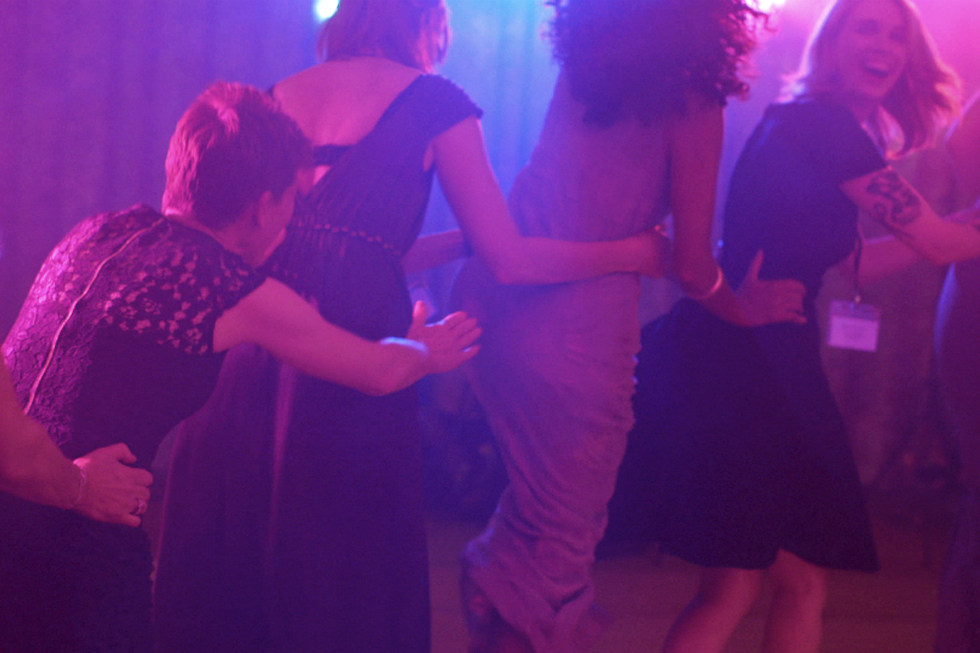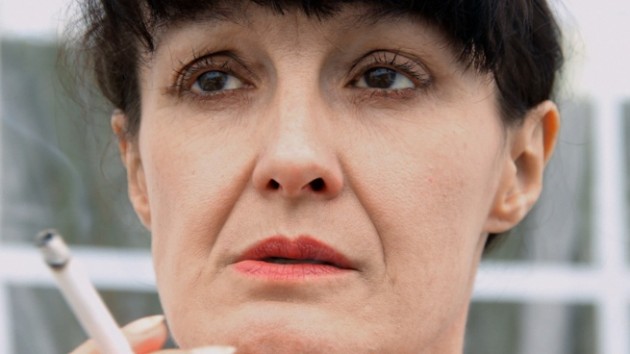“Vibrating pads and gargling salt water”: Lucy Beech’s Me And Mine — Reviewed

Tupperware, networking and Weight Watchers: Amelia Crouch finds herself drawn into the world of female self-help groups via Lucy Beech’s “ambitious” new solo exhibition at the Harris Museum and Art Gallery…
“You’ll be known as ‘garlic bread’ […] and Dorothy, you’re a blini.” So Helen, the hostess of a lunch club come self-help group in Lucy Beech’s 2013 short film Cannibals, tells her new recruits. Each newcomer is allocated an appetiser, whilst returning members are ascribed a main course or – in the case of Helen who is ‘graduating’ – the dessert.
We watch the women clutching their dishes, covered in tin foil, as they file through a house and into a mini marquee in the garden. Here they sit on a circle of exercise mats, sharing emotional experiences and undergoing a series of “tenderising” procedures that include wearing vibrating pads and gargling salt water, before moving on to the meal.
The exact purpose of this six-strong female gathering remains oblique, yet the film is peppered with language and motifs that evoke groups such as Weight Watchers, yoga or pyramid financial schemes. The women are there to “achieve full financial value and emotional support.”
A concern with contemporary female identity, and with the role of the individual in the group, pervades this and the other two works in Beech’s exhibition at the Harris Mueseum and Art Gallery in Preston. Buried Alive (2013) depicts a fictitious leadership workshop in two looping short films, screened on adjacent flat screen monitors, whilst Me and Mine (2015), a 35 minute single screen projection commissioned by Film and Video Umbrella, is centred on an awards ceremony for women in the funeral industry. The films are fictitious but anchored in the real world: Beech fabricates them from ‘field notes,’ collected through workshops and networking events.
The content for Cannibals came from research into multi-level marketing schemes and the all-female support group Women Empowering Women. Me and Mine saw Beech attending and documenting the Good Funeral Awards as part of her research. Both films contain passages which I suspect are drawn directly from ‘real’ people: a character in Cannibals reveals her addiction to online poker; an award recipient in Me and Mine describes how 30 years ago people would presume she was a nurse or solicitor – anything but the funeral director. These stories lead me to empathise with the films’ characters even whilst elements of their behaviour are absurd or unlikeable.

The women in Beech’s films are not everywoman. They are all white, neither very young nor very old, and probably middle class. It’s a demographic with which I overlap and I recognise some of its tropes – I find myself wondering when I learnt the word ‘blini’ – yet the experiences depicted are not universal, Beech taps into something pertinent about contemporary culture: the women are all searching for meaningful connections to others in world where ‘self’ has become a construct or commodity, and where interpersonal relationships are infected by corporate rhetoric.
Me and Mine turns our attention to the professional domain of the funeral industry – an industry historically dominated by men. The film moves between the workplaces of two female funeral directors, who represent contrasting approaches to the profession, and scenes from an awards ceremony weekend where their paths cross. As the narrative unfolds the main protagonist – who works in a traditional undertakers, and is arguably a trailblazer for the role of women in a man’s world – is sidelined by a second protagonist (who works for ‘Eco Alternatives’) and her peers. The latter purportedly represent an industry trend toward a feminised, empathetic approach, yet they uncaringly exclude one who does not adhere to their methodology.
Me and Mine can be read as both a celebration of female agency and as a critique of how this agency is limited and curtailed. Yes, more women are working as funeral directors, but are their roles proscribed anew by a culturally constructed ‘female’ way of doing things?
It is an ambitious film involving a large cast, more complex locations and a significantly longer duration than the exhibited earlier works. However, its structure and visual style are less resolved. On first viewing, I missed some of the film’s more subtle narrative cues. There is a tension between non-linear time – where events involving the same characters in different locations are intercut – and the linearity imposed by a longer format film. In contrast, the shorter looping structures of Cannibals and Buried Alive invite repeat or partial viewing, more suitable for the gallery context.
In Buried Alive, the simultaneously empowering and distancing verbal language (women are being trained to start businesses in which they will help other women to “imagine another future” and “remarket” themselves) is echoed by the film’s visuals. On one screen, participants bury a group member on a sandy beach. As their hands scrabble to release her, they cajole: “Well done”, and she asks: “Do you want me running into the sea?” The film cuts to a shot of the woman in her bathing suit doing just that and it is reminiscent of ‘before’ and ‘after’ weight loss images, or so many similar advertisements extolling a happy life. On the second screen, we watch a kind of guided meditation; cutting between the omniscient camera footage and mobile phone footage shot by an actor-participant – who documents her experience, as if to authenticate it. This inserted ‘amateur’ footage reinforces the message that the group is less to do with genuine relationships, and more about constructing believable representations of relationships.
Perhaps Me and Mine’s cool, unobtrusive visual language is intended to mimic the sleek but generic hotel in which the awards ceremony takes place and to foreground how we distance ourselves from death (whether via traditional or more contemporary ‘alternative’ means), but I found myself wishing for something messier, more visceral. In Cannibals, there is a compelling, ever present physicality; from the vibrating flesh of women’s bodies, to the film’s closing sequence, where the participants consume their starters in close up. As we watch mouths tearing apart morsels of food, Dorothy – the film’s protagonist – imagines biting through her own glands, her own muscle, and in the voiceover soundtrack, she describes consuming herself.
Cannibals ends with Dorothy neatly encasing a desert in Tupperware and placing it in the fridge. Is she saving it for when she completes her ascent through the lunch-club scheme? Or is she packing it away and disconnecting from the group? This ambivalence, and the contrast between the film’s tactile and dispassionate elements, encapsulates the best of Beech’s ability to simultaneously champion and question contemporary female roles.
Amelia Crouch
See Lucy Beech, Me and Mine, at the Harris Museum, Preston, until 4 July 2015 — free entry
This article has been commissioned by the Contemporary Visual Arts Network North West (CVAN NW), as part of a regional critical writing development programme, supported by the National Lottery through Arts Council England — see more here #writecritical





